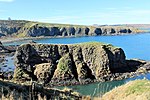Craiglethy
Aberdeenshire geography stubsIslands of ScotlandIslands of the North SeaLandforms of AberdeenshireSkerries of Scotland

Craiglethy (Scottish Gaelic: Creag Liathach - meaning grey rock) is a small island/skerry off Fowlsheugh on the east coast of Aberdeenshire, Scotland in the North Sea. As it is part of Fowlsheugh, it is an SSSI, with many seabirds and seals living on it. It is also one of the few islands on the east coast of Scotland, along with Mugdrum Island and Inchcape, apart from the Islands of the Forth.
Excerpt from the Wikipedia article Craiglethy (License: CC BY-SA 3.0, Authors, Images).Craiglethy
Geographical coordinates (GPS) Address Nearby Places Show on map
Geographical coordinates (GPS)
| Latitude | Longitude |
|---|---|
| N 56.922777777778 ° | E -2.1966666666667 ° |
Address
Uras Knaps
AB39 2TP
Scotland, United Kingdom
Open on Google Maps







